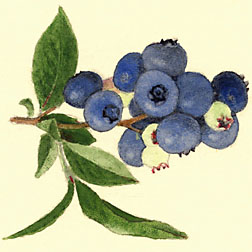This page has been archived and is being provided for reference purposes only. The page is no longer being updated, and therefore, links on the page may be invalid.
| Read the magazine story to find out more. |
|
|
Historic Collection at NAL Gives Insight into Blueberry's Domestication
By Kim KaplanJune 16, 2011
The blueberry was not a cultivated crop until the early 1900s, making it one of the most recent to be domesticated. Before that, blueberries were picked from the wild or bushes were dug from the wild that might or might not survive when they were planted elsewhere.
It was botanist Frederick Coville with the U.S. Department of Agriculture (USDA) who solved the mysteries that transformed blueberries from a crop picked from the wild and sold for 14 cents a quart in 1912 to a commercially grown crop worth more than $530 million today.
Now, Coville's handwritten notes and other research material have been added to the Rare and Special Collections at the National Agricultural Library (NAL) in Beltsville, Md. NAL is part of the Agricultural Research Service (ARS), the chief intramural scientific research agency of USDA.
Coville's records provide amazing insight into how monumental a task it was to begin transforming blueberries into a domesticated crop.
In 1910, Coville published "Experiments in Blueberry Culture" (USDA Bulletin 193), with the first successful, scientific instructions for growing blueberries. He had figured out that blueberry bushes require soil more acid than nearly any other crop cultivated.
Then came Coville's landmark, first successful crosses between two wild blueberries—one highbush and one lowbush—in 1911.
Coville's crosses were released for many years, including after his death in 1937. His "Bluecrop," "Blueray" and "Earliblue" varieties are still popular today with gardeners and commercial growers. By 1942, of the 18 blueberry varieties for eastern growers, 14 were the result of Coville's selection or breeding. His varieties remain part of the pedigree of most varieties grown today.
Coville's research notes will give historians and scientists an opportunity to follow both the thinking and progress of one of the foremost breeders in the world as well the original breeding approaches taken for blueberry disease control, production and other traits.
NAL's Rare and Special Collections hopes to raise funds to scan the Coville records along with the other blueberry material it has recently received so that the records can be available on the Internet.
Read more about the Coville collection in the May/June 2011 issue of Agricultural Research magazine.

